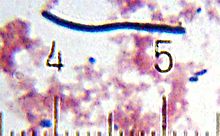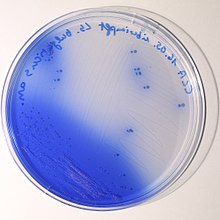
In biochemistry, fermentation theory refers to the historical study of models of natural fermentation processes, especially alcoholic and lactic acid fermentation. Notable contributors to the theory include Justus Von Liebig and Louis Pasteur, the latter of whom developed a purely microbial basis for the fermentation process based on his experiments. Pasteur's work on fermentation later led to his development of the germ theory of disease, which put the concept of spontaneous generation to rest. Although the fermentation process had been used extensively throughout history prior to the origin of Pasteur's prevailing theories, the underlying biological and chemical processes were not fully understood. In the contemporary, fermentation is used in the production of various alcoholic beverages, foodstuffs, and medications.

Yogurt is a food produced by bacterial fermentation of milk. Fermentation of sugars in the milk by these bacteria produces lactic acid, which acts on milk protein to give yogurt its texture and characteristic tart flavor. Cow's milk is most commonly used to make yogurt. Milk from water buffalo, goats, ewes, mares, camels, and yaks is also used to produce yogurt. The milk used may be homogenized or not. It may be pasteurized or raw. Each type of milk produces substantially different results.

Lactic acid is an organic acid. It has the molecular formula C3H6O3. It is white in the solid state and it is miscible with water. When in the dissolved state, it forms a colorless solution. Production includes both artificial synthesis as well as natural sources. Lactic acid is an alpha-hydroxy acid (AHA) due to the presence of a hydroxyl group adjacent to the carboxyl group. It is used as a synthetic intermediate in many organic synthesis industries and in various biochemical industries. The conjugate base of lactic acid is called lactate (or the lactate anion). The name of the derived acyl group is lactoyl.
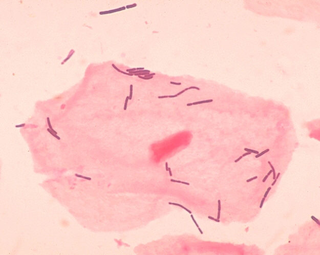
Lactobacillus is a genus of gram-positive, aerotolerant anaerobes or microaerophilic, rod-shaped, non-spore-forming bacteria. Until 2020, the genus Lactobacillus comprised over 260 phylogenetically, ecologically, and metabolically diverse species; a taxonomic revision of the genus assigned lactobacilli to 25 genera.

Lactic acid fermentation is a metabolic process by which glucose or other six-carbon sugars are converted into cellular energy and the metabolite lactate, which is lactic acid in solution. It is an anaerobic fermentation reaction that occurs in some bacteria and animal cells, such as muscle cells.

Probiotics are live microorganisms promoted with claims that they provide health benefits when consumed, generally by improving or restoring the gut microbiota. Probiotics are considered generally safe to consume, but may cause bacteria-host interactions and unwanted side effects in rare cases. There is some evidence that probiotics are beneficial for some conditions, such as helping to ease some symptoms of irritable bowel syndrome (IBS). However, many claimed health benefits, such as treating eczema, lack substantial scientific support.

Lactobacillus acidophilus is a rod-shaped, Gram-positive, homofermentative, anaerobic microbe first isolated from infant feces in the year 1900. The species is commonly found in humans, specifically the gastrointestinal tract and oral cavity as well as some speciality fermented foods such as fermented milk or yogurt, though it is not the most common species for this. The species most readily grows at low pH levels, and has an optimum growth temperature of 37 °C. Certain strains of L. acidophilus show strong probiotic effects, and are commercially used in dairy production. The genome of L. acidophilus has been sequenced.

Skyr is a traditional Icelandic cultured dairy product. It has the consistency of strained yogurt, but a milder flavor. Skyr can be classified as a fresh sour milk cheese, similar to curd cheese consumed like a yogurt in the Baltic states, the Low Countries and Germany. It has been a part of Icelandic cuisine for centuries.

Lactobacillales are an order of gram-positive, low-GC, acid-tolerant, generally nonsporulating, nonrespiring, either rod-shaped (bacilli) or spherical (cocci) bacteria that share common metabolic and physiological characteristics. These bacteria, usually found in decomposing plants and milk products, produce lactic acid as the major metabolic end product of carbohydrate fermentation, giving them the common name lactic acid bacteria (LAB).

Food microbiology is the study of the microorganisms that inhabit, create, or contaminate food. This includes the study of microorganisms causing food spoilage; pathogens that may cause disease ; microbes used to produce fermented foods such as cheese, yogurt, bread, beer, and wine; and microbes with other useful roles, such as producing probiotics.

Streptococcus thermophilus formerly known as Streptococcus salivarius subsp. thermophilus is a gram-positive bacterium, and a fermentative facultative anaerobe, of the viridans group. It tests negative for cytochrome, oxidase, and catalase, and positive for alpha-hemolytic activity. It is non-motile and does not form endospores. S. thermophilus is fimbriated.
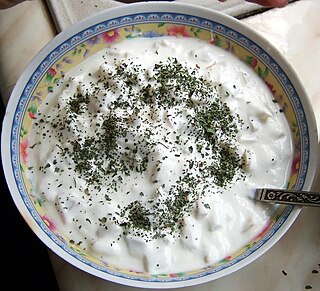
Matzoon or matsoni is a fermented milk product of Armenian origin found in Armenia and Georgia. The Caspian Sea yogurt commercialized in Japan is said to be the same type of yogurt as matzoon, but a comparison of microbiota and viscosity found that the two are entirely different. Georgian Matsoni has been a protected geographical indication in Georgia since 24 January 2012.
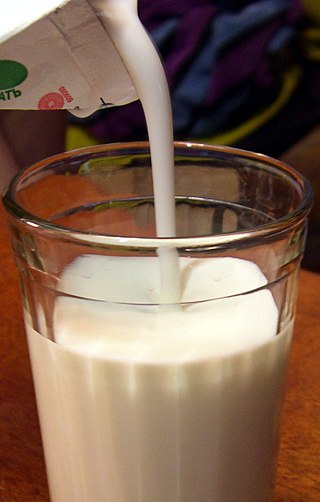
Kefir is a fermented milk drink similar to a thin yogurt or ayran that is made from kefir grains, a specific type of mesophilic symbiotic culture. It is prepared by inoculating the milk of cows, goats, or sheep with kefir grains.

Lactobacillus delbrueckii subsp. bulgaricus is a bacterial subspecies traditionally isolated from European yogurts. Lactobacillus bulgaricusGLB44 differs from other L. bulgaricus strains, because it was isolated from the leaves of Galanthus nivalis in Bulgaria.

Lactobacillus delbrueckii is a species of bacteria in the family Lactobacillaceae. It is part of the microbiota of the lower reproductive tract of women.

Ryazhenka, or ryazhanka, is a traditional fermented milk product in Belarus, Russia, and Ukraine. It is made from baked milk by lactic acid fermentation.

Dahi or curd, also mosaru, dahi, thayir and perugu, is a traditional yogurt or fermented milk product originating from and popular throughout the Indian subcontinent. It is usually prepared from cows' milk, and sometimes buffalo milk or goat milk. The word curd is used in Indian English to refer to homemade yogurt, while the term yogurt refers to the pasteurized commercial variety known as "heat-treated fermented milk".
Postbiotics - also known as metabiotics, biogenics, or simply metabolites - are soluble factors, secreted by live bacteria, or released after bacterial lysis providing physiological benefits to the host.

Yayık ayranı, also known as Turkish buttermilk, is a traditional Turkish drink produced from fermented buttermaking by-products, water and salt. It has been traditionally prepared in barrel churns or skin bags. Despite the similar name, it is distinct from ayran. Goat, sheep, or cow's milk can be used for Turkish buttermilk production. Certain acid curd cheeses such as çökelek could also be obtained from yayık ayranı when heated.
